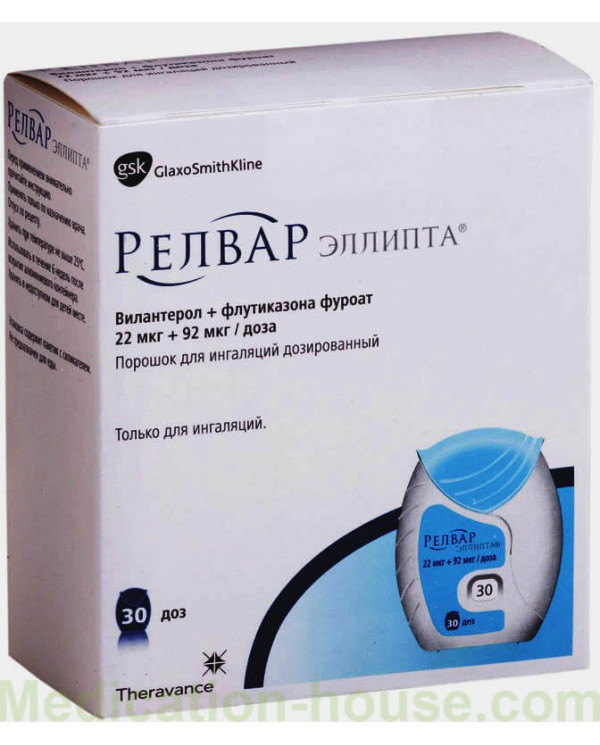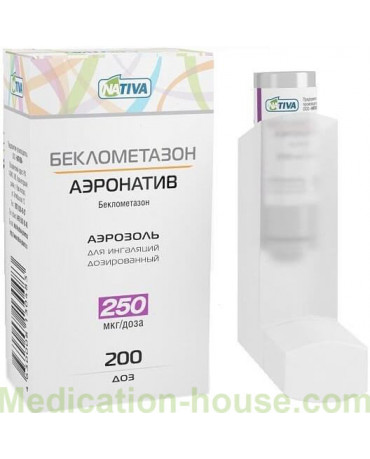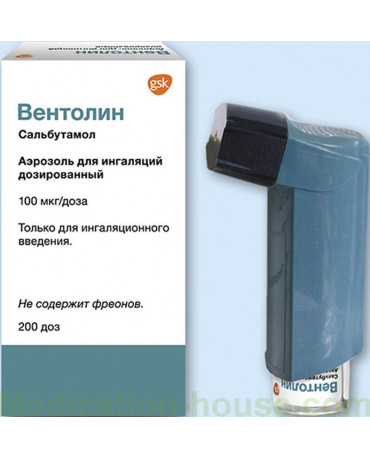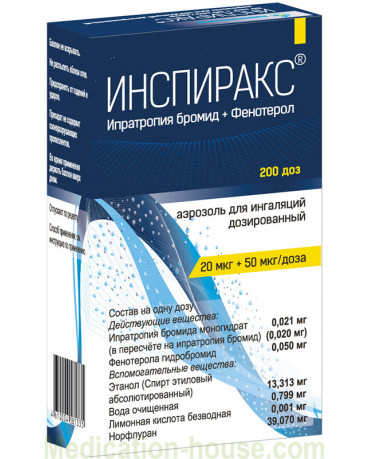Instruction for Relvar Ellipta
You can buy Relvar Ellipta here
Relvar Ellipta is a combined bronchodilating agent with anti-inflammatory effect.
Release form and composition
The drug is released in the form of a metered-dose powder for inhalation of white color (22 μg + 92 μg / dose or 22 μg + 184 μg / dose; 30 doses in a plastic inhaler with a light gray body, a pale blue mouthpiece cap and dose counter; the inhaler contains 2 aluminum laminated strips of 30 evenly distributed cells with powder; 1 inhaler is sealed in a multilayer container of easily opening aluminum foil, in a cardboard box contains 1 container and instructions for use Relvar Ellipta).
The composition of the powder for inhalation in 1 dose / well * 22 μg + 92 μg / 22 μg + 184 μg:
strip with vilanterol: the active substance is vilanterol triphenatate micronized at a dose of 40 mcg (equivalent to vilanterol in an amount of 25 mcg **); excipients - magnesium stearate; lactose monohydrate;
strip with fluticasone furoate: the active substance is fluticasone furoate micronized at a dose of 100 μg ** (22 μg + 92 μg) or 200 μg ** (22 μg + 184 μg); excipient - lactose monohydrate.
* in order to compensate for losses in filling the cells, mixtures of active and auxiliary substances during the production of the finished medicinal product can be placed in the final product with an excess of up to 8%.
** the nominal amount of the active substance laid during production is indicated; the delivered amount is: vilanterol - 22 mcg, fluticasone furoate - 92 and 184 mcg, which corresponds to the indicated dosages.
Pharmacodynamics
The pharmacological effectiveness of the Relvar Ellipta is due to the action of each of its active components:
vilanterol: selective long-acting β2-adrenergic agonist (DDBA); The therapeutic effect of β2-adrenergic receptor agonists, including vilanterol, is at least to some extent associated with stimulation of intracellular adenylate cyclase, an enzyme that catalyzes the conversion of adenosine triphosphate (ATP) to cyclic 3 ', 5'-adenosine monophosphate (cyclic AMP). With an increase in the level of cyclic AMP, the smooth muscles of the bronchi relax and the release of immediate-type hypersensitivity reactions from the cells (mainly from obese) of mediators is suppressed;
fluticasone furoate: synthetic glucocorticosteroid trifluoride (GCS) with pronounced anti-inflammatory activity; the exact mechanism of its action, which provides relief of symptoms of chronic obstructive pulmonary disease (COPD) and bronchial asthma, is unclear. GCS have a wide spectrum of efficacy in relation to various types of cells (e.g., lymphocytes, macrophages, eosinophils) and mediators (e.g., cytokines and chemokines involved in the course of the inflammatory reaction).
Between DBA and GCS there are interactions at the molecular level, due to which steroid hormones excite the β2-adrenergic receptor gene, increasing the number of sensitive adrenergic receptors. DDBA binds to the corticosteroids receptor, resulting in steroid-dependent activation of the latter and stimulation of translocation into the cell nucleus. These synergistic interactions provide an increase in anti-inflammatory activity, which was recorded during in vitro and in vivo experiments with various inflammatory cells associated with the pathophysiological processes of the onset of COPD and bronchial asthma.
Clinical studies using airway biopsy specimens have also indicated a synergistic effect of DBA and GCS arising from the administration of these drugs to patients with COPD in therapeutic doses.
Pharmacokinetics
The absolute bioavailability of vilanterol and fluticasone furoate upon inhalation of a combination of these active substances was approximately 27.3 and 15.2%, respectively. In the case of oral use, their bioavailability was negligible and averaged less than 2 and 1.26%, respectively. The systemic effect of the Relvar Ellipta after inhalation is primarily due to the absorption of part of the powder that has been delivered to the lungs by inhalation (given the low oral bioavailability of both substances).
After intravenous (iv) administration of vilanterol and fluticasone, furoates are widely distributed, while the average distribution volumes (Vd) in equilibrium are 165 and 661 l, respectively. Both active components are characterized by a low ability to bind to red blood cells. According to in vitro studies, the connection with plasma proteins, including in patients with functional disorders of the liver and kidneys, was high and reached approximately 93.9 for vilanterol and more than 99.6% for fluticasone furoate.
Both active ingredients of the Relvar Ellipta relate to substrates of P-glycoprotein (P-gp), however, when the combination of these components with P-gp inhibitors is combined, a change in the systemic exposure of vilanterol or fluticasone furoate is unlikely, since both substances have a high absorption capacity.
According to the results of in vitro experiments, the main metabolic pathways of fluticasone furoate and vilanterol in humans are mainly mediated by the cytochrome CYP3A4 isoenzyme. Vilanterol is metabolized for the most part through O-dealkylation with the formation of a number of metabolites that exhibit significantly lower β1 and β2-adrenomimetic activity. The biotransformation of fluticasone furoate proceeds predominantly by hydrolysis of the S-fluoromethylcarbothioate group with the formation of metabolites with significantly lower GCS activity.
A clinical study of the drug interactions of the Relvar Ellipta with the CYP3A4 isoenzyme was carried out by continuously administering to healthy volunteers a combination of vilanterol and fluticasone furoate (22 μg + 184 μg / dose) and ketoconazole (a potent inhibitor of the CYP3A4 isoenzyme) at a dose of 400 mg. The combined use of drugs caused an increase in the average maximum concentration (Cmax) and the average area under the pharmacokinetic curve (AUC0-24) of fluticasone furoate by 33 and 36%, respectively. An increase in the exposure of fluticasone furoate was associated with a decrease in the average serum cortisol level by 27%, measured over a period of 0-24 hours. Against the background of the simultaneous administration of a combination of vilanterol and fluticasone furoate and ketoconazole, an increase in the mean values of Cmax and AUC (0 – t) of vilanterol increased by 22 and 65% respectively. The prolonged exposure of vilanterol did not enhance the systemic effects that are characteristic of β-agonists with respect to heart rate (HR), corrected QT interval (QTcF) or potassium levels in the blood.
After oral administration of fluticasone, furoate predominantly underwent biotransformation with the formation of metabolites, most of which are excreted through the gastrointestinal tract (GIT), except for a dose of a radioactive substance of less than 1% excreted in the urine. The estimated half-life (T1 / 2) from plasma after inhalation administration was approximately 24 hours.
After oral administration, vilanterol was biotransformed in the body with the formation of metabolites excreted in feces and urine in a ratio of about 30 and 70% of the dose of the radioactive substance, respectively. When inhaled, the combination of vilanterol and fluticasone furoate T1 / 2 of vilanterol from plasma was approximately 2.5 hours.
In clinical trials of patients with bronchial asthma and COPD, immigrants from Japan, East and Southeast Asia (12-14% of patients), showed an average higher AUC0-24, but not higher than 53%, of fluticasone furoate in comparison with patients of the Caucasian race. At the same time, in these populations there were no signs indicating a higher systemic exposure associated with an increased effect on the daily excretion of cortisol in the urine.
In patients with COPD, no effect of race on the pharmacokinetic characteristics of Vilanterol was found. According to the results of the studies, the values of Cmax of vilanterol were 220–287% higher, and AUC0–24 were comparable in patients of Asian origin with corresponding parameters in representatives of other racial groups. However, with a higher Cmax of vilanterol, no clinically significant effect on heart rate was found.
According to the results of a pharmacokinetic analysis of the effect of body weight, body mass index (BMI) and gender on the pharmacokinetic profile of vilanterol and fluticasone furoate in patients with bronchial asthma or COPD were not found. Individual selection of the dose of the Relvar Ellipta based on data on body weight, BMI and gender is not required.
Indications for use
bronchial asthma (as a supportive treatment);
COPD (as a supportive treatment for airway obstruction in patients with COPD, including chronic bronchitis and / or pulmonary emphysema).
The use of the Relvar Ellipta helps reduce the number of exacerbations of COPD in the presence of repeated exacerbations in history.
Contraindications
Absolute:
age up to 12 years (for the treatment of bronchial asthma);
age up to 18 years (for the treatment of COPD);
hypersensitivity to any of the components of the drug or severe allergic reactions to milk protein in history.
Relvar Ellipta 22 mcg + 184 mcg / dose is not prescribed for the treatment of COPD.
Relative contraindications (the drug must be used with caution):
pulmonary tuberculosis; the presence of chronic or untreated infections (due to part of the SCS);
severe forms of cardiovascular disease (due to the increased risk of developing arrhythmias, including supraventricular tachycardia and extrasystole).
Relvar Ellipta, instructions for use: method and dosage
The Relvar Ellipta is used only by inhalation, once a day (morning or evening at the same time). After inhalation, it is recommended to rinse your mouth with water without swallowing it.
Patients with asthma require inhalation of the drug, even with an asymptomatic course of the disease. In the event of asthma symptoms occurring between administrations, for the immediate weakening of their severity, β2-agonists of short action in an inhaled form should be used. The doctor needs to regularly evaluate the patient's condition for the timely appointment, if necessary, of the optimal dosage of Relvar Ellipta. Correcting the dosage regimen is allowed only after consulting a physician.
Adolescents over 12 years of age and adults are recommended to carry out 1 inhalation per day at a dose of 22 mcg + 92 mcg or at a dose of 22 mcg + 184 mcg.
Relvar Ellipta 22 μg + 92 μg is prescribed as an initial dose for patients who need low or medium doses of inhaled GCS in combination with long-acting β2-agonists, and a dosage of 22 μg + 184 μg for patients who need a higher dose of inhaled GCS with β2 agonists.
If the administration of the drug in a dosage of 22 μg + 92 μg cannot lead to adequate control of bronchial asthma, it is possible to increase the dose to 22 μg + 184 μg to provide better control over the course of the disease.
Adult patients with COPD are advised to take 1 inhalation Relvar Ellipta 22 mcg + 92 mcg per day; do not use a drug at a dosage of 22 mcg + 184 mcg for the treatment of this disease.
Rules for use of the inhaler
If the inhaler is used for the first time, there is no need for special preparation for its operation or to verify the correctness of its operation. The following recommendations for use should be observed in stages:
The container in which the inhaler is packed contains a moisture-absorbing bag with silica gel, not intended for inhalation or eating, it must be disposed of.
After the inhaler is removed from the container, the lid in the closed position should not be opened before drug administration. If you open and close the inhaler cap without taking the medicine, a dose loss will occur. This lost dose will be securely closed inside the inhaler and not available for use. It is not possible to accidentally administer a large or double dose in one inhalation.
After each opening of the lid, one dose of the drug is ready for inhalation. The dose counter shows how many doses the Relvar Ellipta remains in the inhaler. Before the start of the first procedure, the counter shows exactly 30 doses, with each subsequent opening of the inhaler cap, the number of doses decreases by one. When less than 10 doses remain, half the counter will turn red. After the last dose is administered, half the meter will be painted red, it will show the number 0, this will mean that the inhaler is empty. If you open the lid after this, the counter will turn completely red.
If you are ready to administer the drug, open the lid and lower it down until it clicks. The drug is ready for inhalation if the counter reduces the number of doses per unit. If the number of doses after a click has not decreased, the inhaler is not ready to supply the drug. In this case, you need to contact by phone or at the address indicated in the section "For more information, contact. Do not shake the inhaler!
During the procedure, before taking the drug, it is required to exhale as deep as possible, holding the inhaler at a certain distance near the mouth. In this case, you should not exhale into the inhaler.
Tightly covering the mouthpiece with your lips and without simultaneously covering the ventilation hole with your fingers, you should take one uniform, long and deep breath. It is required to hold your breath as much as possible, but not less than 3-4 seconds. Then you need to remove the inhaler from the mouth and calmly and slowly exhale. If the procedure is carried out correctly, the flow of the drug may not be felt or its taste may not be felt.
If necessary, clean the mouthpiece with a dry paper towel before closing the lid. To completely close the mouthpiece, pull the lid up until it stops. After using the inhaler, it is recommended to rinse your mouth with water to reduce the risk of adverse reactions such as pain in the mouth and throat.
Side effects
Adverse reactions observed during large-scale clinical trials among patients with bronchial asthma and COPD:
nervous system: very often - headache;
infectious and parasitic lesions: often - candidiasis of the oral cavity and pharynx, flu, upper respiratory tract infection, bronchitis, pneumonia;
cardiovascular system: infrequently - extrasystole;
digestive system: often - abdominal pain;
respiratory system: very often - nasopharyngitis; often - rhinitis, pharyngitis, sinusitis, cough, dysphonia, oropharyngeal pain;
musculoskeletal system: often - back pain, arthralgia, fractures;
general disorders: often - fever.
The safety profiles of the Relvar Ellipta in patients with COPD and bronchial asthma were similar, except for pneumonia and fractures, which were most often observed during clinical trials in patients suffering from COPD.
Violations recorded according to the data of post-registration observation:
immune system: rarely - hypersensitivity reactions, including urticaria, rash, angioedema, anaphylaxis;
cardiovascular system: rarely - palpitations, tachycardia;
respiratory system: rarely - paradoxical bronchospasm;
musculoskeletal system: often - muscle spasm;
nervous system: rarely - tremor;
mental disorders: rarely - anxiety.
Overdose
There are no data on overdose with the combined use of vilanterol and fluticasone furoate. Against the background of an overdose, the Relvar Ellipta may experience symptoms caused by the action of its individual components, which are characteristic of an overdose of inhaled corticosteroids and β2-agonists.
There are no specific overdose therapy methods. Symptomatic treatment is recommended, as well as monitoring the patient, if necessary. Cardioselective β-blockers are prescribed only if pronounced overdose reactions of vilanterol occur, which are immune to maintenance therapy. In the event of a history of bronchospasm, cardioselective β-blockers must be used with caution.
special instructions
The Relvar Ellipta is not indicated for the relief of exacerbation of COPD or acute symptoms of bronchial asthma, in these cases the use of short-acting bronchodilators is necessary. With an increase in the frequency of taking the latter in order to stop symptoms, it is necessary to improve control of the disease after consulting a doctor.
Patients with bronchial asthma or COPD should not discontinue therapy with the drug without the supervision of a specialist, since failure to use the drug can cause symptoms to resume.
After administration of the drug, as with other types of inhalation treatment, there is a risk of paradoxical bronchospasm, accompanied by a rapid increase in wheezing. The development of this complication requires the urgent use of a short-acting inhaled bronchodilator and the immediate cancellation of the Relvar Ellipta. The attending physician evaluates the patient's condition and, if necessary, may prescribe alternative therapy.
During treatment with the drug, the development of undesirable phenomena associated with the course of bronchial asthma or an exacerbation of the disease is possible. Under these conditions, it is recommended to continue taking the Relvar Ellipta. It is urgent to seek medical advice if the patient worsens at the beginning of the course or fails to establish control over the disease.
The use of any inhaled GCS, especially for a long time in high doses, can contribute to the development of systemic side effects. Such violations occur much less frequently than during treatment with oral corticosteroids. The following reactions may be manifestations of a possible adverse systemic effect: glaucoma, cataract, decreased bone mineral density, inhibition of the function of the hypothalamic-pituitary-adrenal system, growth retardation in children and adolescents.
In patients with COPD during treatment with Relvar Ellipta, an increase in the incidence of pneumonia was recorded, including severe forms of the disease requiring hospitalization of the patient (in some cases, fatal). In the presence of COPD, the risk of developing pneumonia must be considered, because the clinical signs of this complication may partially coincide with the symptoms of exacerbation of COPD. The likelihood of developing pneumonia during the period of drug therapy in patients with COPD is aggravated with the following risk factors: history of pneumonia, smoking, BMI less than 25 kg / m², predicted forced expiratory volume in the first second (FEV 1) less than 50% of the required values . These factors should be considered when prescribing the drug, and in the case of pneumonia, treatment should be reviewed.
The episodes of pneumonia in patients with bronchial asthma were recorded infrequently. While Relvar Ellipta is used, 22 mcg + 184 mcg / dose in patients with asthma, an increased risk of pneumonia is possible when compared with patients using the drug 22 mcg + 92 mcg / dose. Risk factors not established.
Influence on the ability to drive vehicles and complex mechanisms
Considering the pharmacology data of fluticasone furoate and vilanterol, the Relvar Ellipta negative effect on the ability to drive vehicles or other complex equipment is not expected.
Pregnancy and lactation
There is insufficient data on the use of the Relvar Ellipta during pregnancy, and therefore the use of the drug in pregnant women is possible only when the expected benefit to the mother exceeds any possible threat to the fetus.
Information on the release of fluticasone furoate or vilanterol, or their metabolites during lactation, is limited. However, it was found that other GCS and β2-agonists penetrate into breast milk, therefore, the risk of excretion of the drug together with milk cannot be ruled out. After assessing the relationship between the benefits of natural feeding for a child and treatment for a woman, it is necessary to resolve the issue of stopping breastfeeding or drug therapy.
There is no evidence of the effect of the Relvar Ellipta on human fertility. In the process of preclinical studies, the effect of the active substances of the drug on fertility was not detected.
Use in childhood
In children under 12 years of age, the pharmacokinetics of the combined use of fluticasone furoate and vilanterol has not been studied. Data confirming the effectiveness and safety of the drug in this age group of patients are currently not available.
According to the evidence of COPD, the Relvar Ellipta is not assigned to children and adolescents under 18 years of age.
In the treatment of bronchial asthma, the use of the drug in children under 12 years of age is contraindicated. For adolescents 12 years of age and older, there are no recommendations for changing the regimen of use of the Relvar Ellipta.
With impaired renal function
The presence of severe renal impairment with creatinine clearance below 30 ml / min according to the results of clinical and pharmacological studies did not cause a marked increase in the systemic exposure of vilanterol / fluticasone furoate or the appearance of more severe systemic effects of corticosteroids / β2-agonists when compared with similar indicators in healthy volunteers. The effect of hemodialysis on the drug has not been investigated.
Individual dose selection for patients with impaired renal function is not required.
With impaired liver function
According to the results of clinical and pharmacological studies in patients with impaired liver activity of mild, moderate and severe degree (according to the Child-Pugh classification of cirrhosis stage A, B or C), a 3-fold increase in the degree of systemic exposure of fluticasone furoate was observed (with an increase in Cmax and AUC ) As a result, patients with impaired hepatic function are required to use the Relvar Ellipta with caution, since in this case the risk of systemic undesirable effects caused by taking GCS is aggravated.
In patients with moderate / severe hepatic impairment, the maximum dose of the Relvar Ellipta should be 22 μg + 92 μg / dose. Patients from this group are required to be under medical supervision to control systemic side effects associated with the use of GCS.
Use in old age
During the III phase of clinical studies in patients over 65 years of age with bronchial asthma, there was no evidence of the effect of age on the pharmacokinetic profile of vilanterol and fluticasone furoate. In elderly patients with COPD, despite an increase in AUC0-24 of vilanterol by 37%, there are no signs of a change in the pharmacokinetic profile of fluticasone furoate due to the influence of age.
Individual selection of the dose of the Relvar Ellipta to patients after 65 years with asthma and COPD is not required.
Drug interaction
β-adrenergic blocking agents: a weakening of the effect of β2-adrenergic agonists or antagonistic action against the latter is noted it is necessary to avoid concomitant use of selective and non-selective β-blockers, except in cases where their appointment is extremely necessary;
strong inhibitors of the cytochrome CYP3A4 isoenzyme (including ritonavir, ketoconazole): it is possible to increase the systemic effects of fluticasone furoate and vilanterol (since both substances undergo primary metabolism in the liver with the participation of the isoenzyme of the CYP3A4 cytochrome system), which may increase the risk of adverse reactions; this combination requires caution;
verapamil (a moderate inhibitor of the cytochrome CYP3A4 isoenzyme): there was no significant effect on the pharmacokinetics of vilanterol during its combination with verapamil and a potent P-gp inhibitor.
When using a bronchodilating agent in therapeutic doses, significant drug interactions of fluticasone furoate and vilanterol are considered unlikely due to low plasma concentrations of these substances as a result of inhalation.
Terms and conditions of storage
Keep out of the reach of children at a temperature not exceeding 25 ° C.
Shelf life is 2 years.
An opened aluminum container should be used within 6 weeks.
Reviews
Reviews of the Relvar Ellipta in most cases are positive. Patients note the effectiveness of the drug with the supportive treatment of bronchial asthma. Thanks to its action, it is possible to reduce the number of exacerbations during the treatment of COPD. The inhaler is designed for 1 month of therapy, is simple and convenient to use, its effect persists for 24 hours after administration.
The lack of the drug, all patients consider its high cost.
Terms of sell
You can buy Relvar Ellipta without a prescription.





